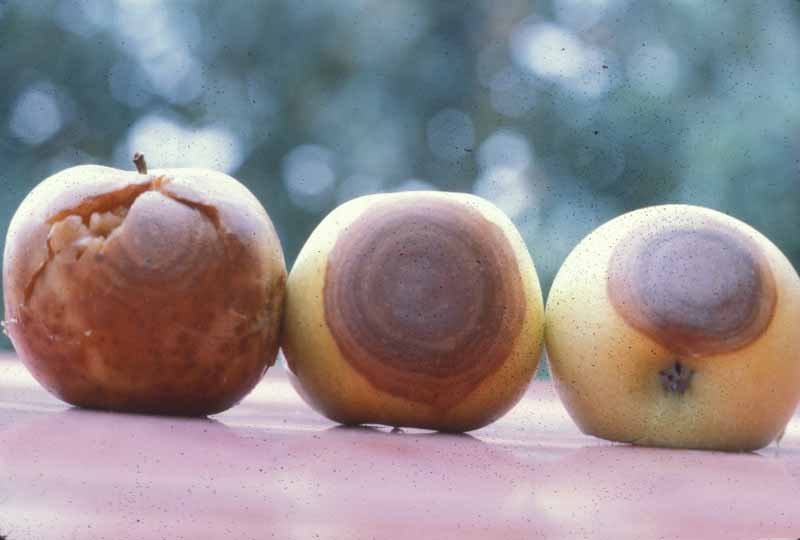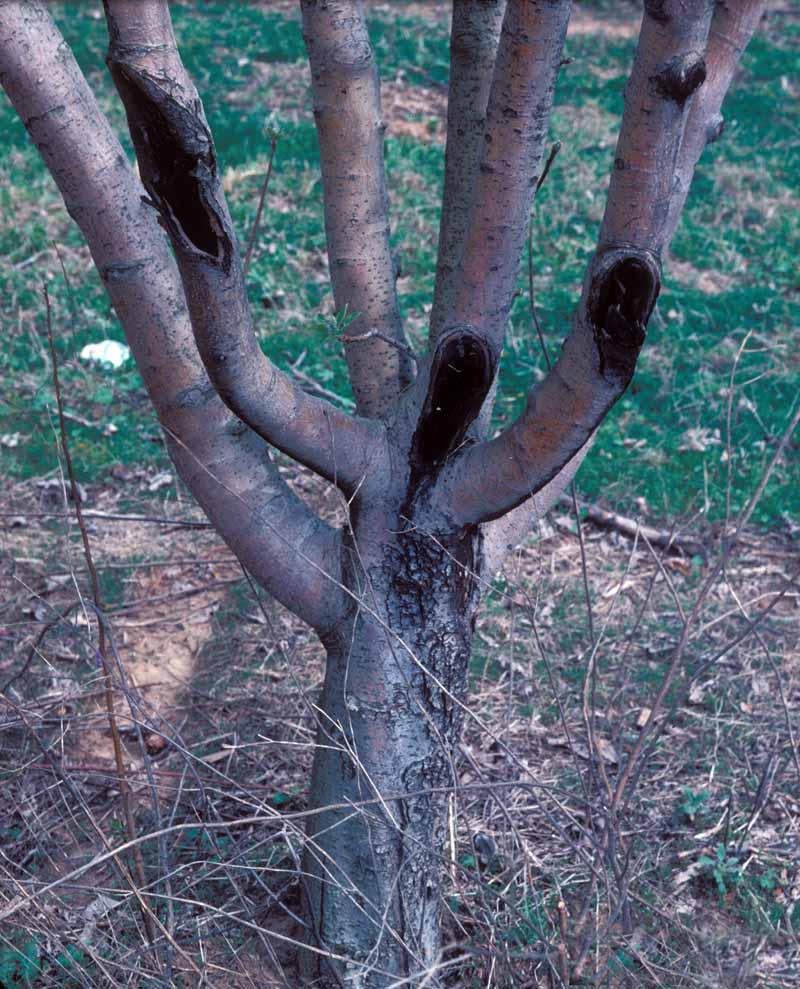Botryosphaeria dothidea
Bot rot, also known as white rot, is caused by the fungus Botryosphaeria dothidea. Infection can result in a complex of diseases – two types of fruit rot and cankers on the limbs and twigs.
This pathogen infects not only apples and crabapples but also a number of woody plants. These include such economically important species as pears, chestnuts, and grape.
Fortunately, this fungus is not much of a predator. It primarily affects trees in a weakened state. A large number of factors can predispose trees to bot rot. These include winter injury, fire blight damage, insect damage, and drought.

We link to vendors to help you find relevant products. If you buy from one of our links, we may earn a commission.
If conditions are right, the fruit rot can cause enormous losses, especially in the southeast. The fungus is mercurial. Some years may result in devastating fruit losses, while it may not even infect fruit the following year.
Since bot rot can mimic other diseases, read on for tips on how to identify this pathogen and control it.
What You Will Learn
Symptoms
Cankers on Twigs and Limbs
This fungus cannot infect trees unless there are breaks or wounds in the epidermis. You will be able to tell if your tree is infected by early summer.
The infections first manifest as small spots that look like blisters. The spots then grow and become full of watery fluid.
If conditions are favorable, the fungus can rapidly grow through the tissue to form dark-colored cankers that are slightly sunken. The cankers can fuse and kill whole large limbs by girdling them. It can even infect the main truck and kill the entire tree.

One characteristic of these types of cankers is that the papery bark on the cankers is orange and can be peeled off the tree easily. The tissues beneath are slimy and brown or watery.
The cankers stop growing in the fall, and small black bodies that produce spores form on the surface of the cankers or under the bark.
Fruit Rots
External Infections
Mature fruits are the most susceptible to bot rot.
The first sign that your fruit are infected are small brown spots that are slightly sunken. They may be surrounded by a red halo. Eventually the core and then the entire fruit rot.
The disease gets its name of white rot because red-skinned apple varieties can bleach and turn light brown.
It can be difficult to tell bot rot from black rot or bitter rot. You can distinguish bot rot from these other diseases by the following features:
- The rotted flesh is firm and leathery when the cause is black rot. With bot rot, the decayed flesh is soft and mushy.
- Bot rots start out shaped like cups or eggs. With bitter rot, the decayed areas are shaped like cones, and the surface manifests concentric rings of spores.
Fruit that are completely rotten may develop black fruiting bodies filled with spores during weather that is above 75 F and moist.
Internal Infections
To the best of our knowledge, no one knows how the internal apple infections develop. They can be insidious, and your fruit can be infected in mid-summer without your knowledge.

However, once you remove them from cold storage, the internal rot develops. The fruit may decay very rapidly at room temperature and can be totally rotten after several days.
How to Control Bot Rot
Commercial growers control bot rot using a combination of cultural practices and fungicide applications. However, if you just have an apple tree or two in your yard, you may be able to control this disease solely by implementing cultural practices and skipping the fungicide applications.
1. Sanitation is Key
Since infected tissue can ooze spores by the thousands, limiting this inoculum is critical to managing bot rot.
Piles of prunings are a key source if inoculum. They should be removed from the orchard or burned. Another option is to chop them with a flat mower. That will remove the bark, so they can decompose faster.
Be sure and remove the mummified apples and prune any dead wood in the tree. This is particularly important for tissue damaged by fire blight, since it can be a key source of bot rot infections.
2. Keep Your Tree Healthy
Since this fungus only infects trees with issues, keeping them healthy and vigorous will go a long way towards preventing infection.
Prune them each year and fertilize precisely based on analyses of the soil and the leaves.
Fortunately You Can Take Measures to Prevent Bot Rot
Considering the horrific damage that the bot rot fungus can cause to the limbs, twigs and the fruit, it is fortunate that you can dramatically increase the resistance of your trees by keeping them healthy.
Purging any potential inoculum and taking proper care of your trees can help keep these potentially serious infections at bay.
If you have fought with bot rot, let us know how you fared in the comments. Read on for information about other apple diseases:
© Ask the Experts, LLC. ALL RIGHTS RESERVED. See our TOS for more details. Uncredited photos: Shutterstock.
If this is bot rot then do they make a chemical to kill that? This is infecting my trees one to another. It seems it is spreading to trees that have perfect apples on them but now they are getting this rot on one, then two and more.
Hi. I was reading this article and saw your comment. We have it on our trees also and I checked with our agricultural extension office. He recommended a fungicide called Captan. I had to order it online but maybe you can find it in a store where you live. Good luck. It’s hard to lose apples you have been working so hard on growing!
I’m sorry to hear that, Floyd. It’s a frustrating disease. A fungicide containing strobilurin (FRAC Group 11 Fungicides) or Captan & Topsin M are effective against bot rot.